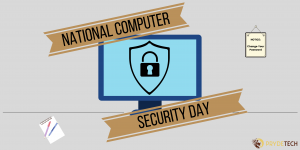
Today is National Computer Security Day! Created in 1988, National Computer Security Day was created to raise awareness and teach users about common cybersecurity issues. Did you know that 95% of cybersecurity breaches happen due to user error (Cybint)? While that is a scary statistic, it really just means that users need to be more educated on what to do and what not to do. This is where we come in! Here are a few best practices that you and your company can use to be more secure.
Use new, strong passwords.
Most users have the strong part down. If you need to create a password, make sure that it has 8+ characters, lower and uppercase letters, a number, and a symbol. Try to use a password that is not the name of someone in your family or a beloved pet, as these are easy passwords to guess. Equally as important though is using different passwords every time you have the opportunity to do so. Using the same password for multiple things makes it easier for hackers to get in. In fact, reusing passwords often makes it more likely for a hacker to access credit card information (CyberTalk)
Do not open suspicious emails.
This one topic could be discussed in detail for an hour. Double-check the sender – some emails get tricky by adding a single dot or letter to make it look legitimate. Thoroughly inspect the content – if your boss is asking you to get gift cards, it is probably not legitimate. When in doubt, do not open the email or click on links inside of it. Ask your technician to take a look at it. Technicians will agree that they would rather take a look at a normal email than deal with the damage that can occur from opening a malicious email.
Keep hardware and software up to date.
If you are not in management, this one may be out of your control. However, if you notice that software or hardware is out of date, be sure to bring it up. Outdated hardware may not support the most recent editions of software, and outdated software is easier to hack into.
Do not leave devices unattended.
When walking away from your computer, press Windows Key + L to lock your screen. Note: This is only effective if you have password-protected your computer. Any laptops or tables should be locked up and inaccessible to anyone other than yourself. Hard drives and flash drives should be encrypted and should also be locked up when stepping away (Berkeley).
Back up your data.
Perhaps the most important thing to remember is to back up your data. While it is important to follow all other security best practices, the truth is that things will happen from time to time. In the event that bad things happen, it is important that data is backed up and can be restored. With that said, the more frequently the information is backed up, the better. If you wouldn’t want to lose what you have been working on since the last time you backed it up, you should back it up again.
This, of course, is not an exhaustive list of best practices. Each of these things could be delved into further, and there are many more best practices that could be discussed. Start with these tips and if you’d like more information, we would be happy to help.


